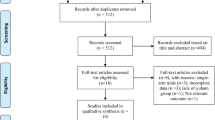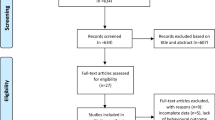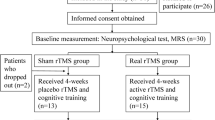Abstract
Alzheimer’s disease (AD) is the most common type of dementia among the elderly. Common treatments available and non-pharmacological interventions have their limitations, and new therapeutic approaches are critically needed. Transcranial magnetic stimulation (TMS) is a non-invasive technique that generates an electric current-inducing modulation in cortical excitability. The previous clinical trials showed that combinations of rTMS and cognitive training (rTMS-COG), as provided by the NeuroAD medical device system, offer a novel, safe, and effective method improving mild-to-moderate AD patients. In this article, we present our experience with rTMS-COG treatment, in clinical settings, of 30 mild-to-moderate AD patients that received rTMS-COG commercial treatments in two clinics for 1-h daily sessions, 5 days per week, for 6 weeks (30 sessions). Five patients returned for a second treatment. ADAS-Cog and MMSE scores were measured pre- and post-treatments. The main analyses were conducted on patients who received 1 treatment (n = 30). Data received from the five returning patients were analyzed separately. The effect of rTMS-COG treatment was statistically significant regarding both ADAS-Cog (−2.4 point improvement, PV <0.001) and MMSE (+1.7 points improvement, PV <0.001) scores. About 80 % of patients gained some cognitive improvement following NeuroAD treatment, with more than 60 % improving by more than two points, for a minimum of 9 months. The Neuronix NeuroAD System was shown to be a safe and effective non-invasive modality for cognitive improvement of Alzheimer patients, with measurable outcomes lasting, in some of them, for up to 1 year, following completion of the 6-week daily intervention course (a carryover effect).

Similar content being viewed by others
References
Ahmed MA, Darwish ES, Khedr EM, El Serogy YM, Ali AM (2012) Effects of low versus high frequencies of repetitive transcranial magnetic stimulation on cognitive function and cortical excitability in Alzheimer’s dementia. J Neurol 259:83–92
Alzheimer’s Association (2013) 2013 Alzheimer’s disease facts and figures. Alzheimers Dement 9:208–245
Bellgowan PS, Buffalo EA, Bodurka J, Martin A (2009) Lateralized spatial and object memory encoding in entorhinal and perirhinal cortices. Learn Mem 16:433–438
Bentwich J, Dobronevsky E, Aichenbaum S, Shorer R, Peretz R, Khaigrekht M, Marton RG, Rabey JM (2011) Beneficial effect of repetitive transcranial magnetic stimulation combined with cognitive training for the treatment of Alzheimer’s disease: a proof of concept study. J Neural Transm 118:463–471
Birks J (2006) Cholinesterase inhibitors for Alzheimer’s disease. Cochrane Database Syst Rev 1:CD005593
Bliss TV, Collingridge GL (1993) A synaptic model of memory: long-term potentiation in the hippocampus. Nature 361:31–39
Brem AK, Schilberg L, Freitas C, Atkinson N, Seligson E, Pascual-Leone A (2013) Effect of cognitive training and rTMS in Alzheimer’s Disease. Alzheimers Dement Suppl 9:S664
Buck BH, Black SE, Behrmann M, Caldwell C, Bronskill MJ (1997) Spatial- and object-based attentional deficits in Alzheimer’s disease. Relationship to HMPAO-SPECT measures of parietal perfusion. Brain 120:1229–1244
Cotelli M, Calabria M, Manenti R, Rosini S, Zanetti O, Cappa SF, Miniussi C (2011) Improved language performance in Alzheimer disease following brain stimulation. J Neurol Neurosurg Psychiatry 82:794–797
Di Lazzaro V, Oliviero A, Pilato F, Saturno E, Dileone M, Marra C, Daniele A, Ghirlanda S, Gainotti G, Tonali PA (2004a) Motor cortex hyperexcitability to transcranial magnetic stimulation in Alzheimer’s disease. J Neurol Neurosurg Psychiatry 75:555–559
Di Lazzaro V, Oliviero A, Pilato F, Saturno E, Dileone M, Mazzone P, Insola A, Tonali PA, Rothwell JC (2004b) The physiological basis of transcranial motor cortex stimulation in conscious humans. Clin Neurophysiol 115:255–266
Fargo KN, Aisen P, Albert M, Au R, Corrada MM, DeKosky S, Drachman D, Fillit H, Gitlin L, Haas M, Herrup K, Kawas C, Khachaturian AS, Khachaturian ZS, Klunk W, Knopman D, Kukull WA, Lamb B, Logsdon RG, Maruff P, Mesulam M, Mobley W, Mohs R, Morgan D, Nixon RA, Paul S, Petersen R, Plassman B, Potter W, Reiman E, Reisberg B, Sano M, Schindler R, Schneider LS, Snyder PJ, Sperling RA,Yaffe K, Bain LJ, Thies WH, Carrillo MC (2014) 2014 Report on the milestones for the US national plan to address Alzheimer's disease. Alzheimer’s Dement 10(5):S430–S452
Folstein MF, Folstein SE, McHugh PR (1975) “Mini-mental state” A practical method for grading the cognitive state of patients for the clinician. J Psychiatr Res 12:189–198
Gilligan AM, Malone DC, Warholak TL, Armstrong EP (2013a) Predictors of hospitalization and institutionalization in Medicaid patient populations with Alzheimer’s Disease. Adv Alzheimer’s Dis 2:74–82
Gilligan AM, Malone DC, Warholak TL, Armstrong EP (2013b) Health disparities in cost of care in patients with Alzheimer’s disease: an analysis across 4 state medicaid populations. Am J Alzheimer’s Dis Other Demen 28(1):84–92
Grafman J, Pascual-Leone A, Alway D, Nichelli P, Gomez-Tortosa E, Hallett M (1994) Induction of a recall deficit by rapid-rate transcranial magnetic stimulation. NeuroReport 5:1157–1160
Grayson VK, Velkoff VA, US Census Bureau (2010) The next four decades: the older population in the United States: 2010 to 2050. In: Current population reports. US Census Bureau, US Department of Commerce, Economics and Statistics Administration, Washington DC, pp 25–1138
Guse B, Falkai P, Wobrock T (2010) Cognitive effects of high-frequency repetitive transcranial magnetic stimulation: a systematic review. J Neural Transm (Vienna) 117:105–122
Harpaz Y, Levkovits Y, Lavidor M (2009) Lexical ambiguity resolution in Wernicke’s area and its right homologue. Cortex 45:1097–1103
Hebert LE, Weuve J, Scherr PA, Evans DA (2013) Alzheimer disease in the United States (2010–2050) estimated using the 2010 census. Neurology 80:1778–1783
Hoogendam JM, Ramakers GM, DiLazzaro V (2010) Physiology of repetitive transcranial magnetic stimulation of the human brain. Brain Stimul 3:95–118
Hoyert DL, Xu J (2012) Deaths: preliminary data for 2011. Natl Vital Stat Rep 61(6):1–51
Ito K, Ahadieh S, Corrigan B, French J, Fullerton T, Tensfeldt T, Alzheimer’s Disease Working Group (2010) Disease progression meta-analysis model in Alzheimer’s disease. Alzheimers Dement 6:39–53
Kammer T, Beck S, Thielsher A, Laubis-Herrmann U, Topka H (2001) Motor thresholds in humans: a transcranial magnetic stimulation study comparing different pulse waveforms, current directions and stimulators types. Clin Neurophysiol 112:250–258
Lee J, Choi BH, Oh E, Sohn EH, Lee AY (2015) Treatment of Alzheimer’s disease with repetitive transcranial magnetic stimulation combined with cognitive training: a prospective, randomized, double-blind, placebo-controlled study. J Clin Neurol 12:57–64
Lefaucheur JP, André-Obadia N, Antal A, Ayache SS, Baeken C, Benninger DH et al (2014) Evidence-based guidelines on the therapeutic use of repetitive transcranial magnetic stimulation (rTMS). Clin Neurophysiol 125:2150–2206
Mohs RC, Knopman D, Petersen RC, Ferris SH, Ernesto C, Grundman M, Sano M, Bieliauskas L, Geldmacher D, Clark C, Thal LJ (1997) Development of cognitive instruments for use in clinical trials of antidementia drugs: additions to the Alzheimer’s Disease Assessment Scale that broaden its scope. The Alzheimer’s Disease Cooperative Study. Alzheimer Dis Assoc Disord 11:S13–S21
NIH National Institute on Aging (2015) Alzheimer’s disease medications fact sheet. Retrieved May 2014, from NIH; National Institute on Aging: http://www.nia.nih.gov/sites/default/files/ad_meds_fact_sheet-2014_update-final_2-12-14.pdf. Accessed 23 May 2014
Olazarán J, Reisberg B, Clare L, Cruz I, Peña-Casanova J, Del Ser T, Woods B, Beck C, Auer S, Lai C, Spector A, Fazio S, Bond J, Kivipelto M, Brodaty H, Rojo JM, Collins H, Teri L, Mittelman M, Orrell M, Feldman HH, Muñiz R (2010) Nonpharmacological therapies in Alzheimer’s disease: a systematic review of efficacy. Dement Geriatr Cogn Dis 30:161–178
Rabey JM, Dobronevsky E, Aichenbaum S, Gonen O, Marton RG, Khaigrekht M (2013) Repetitive transcranial magnetic stimulation combined with cognitive training is a safe and effective modality for the treatment of Alzheimer’s disease: a randomized, double-blind study. J Neural Transm 120:813–819
Reichman WE, Fiocco AJ, Rose NS (2010) Exercising the brain to avoid cognitive decline: examining the evidence. Aging Health 6:565–584
Rogalsky C, Matchin W, Hickok G (2008) Broca’s area, sentence comprehension, and working memory: an fMRI Study. Front Hum Neurosci 2:14
Rossi S, Hallett M, Rossini PM, Pascual-Leone A, Safety of TMS Consensus Group (2009) Safety, ethical considerations, and application guidelines for the use of transcranial magnetic stimulation in clinical practice and research. Clin Neurophysiol 120:2008–2039
Schrag A, Schott JM (2012) What is the clinically relevant change on the ADAS-Cog? J Neurol Neurosurg Psychiatry 83:171–173
Siebner HR, Rothwell J (2003) Transcranial magnetic stimulation: new insights into representational cortical plasticity. Exp Brain Res 148:1–16
Sitzer DI, Twamley EW, Jeste DV (2006) Cognitive training in Alzheimer’s disease: a meta-analysis of the literature. Acta Psychiatr Scand 114:75–90
Xie J, Brayne C, Matthews FE, Medical Research Council Cognitive Function and Ageing Study collaborators (2008) Survival times in people with dementia: analysis from population based cohort study with 14 year follow-up. BMJ 336:258–262
Zheng XM (2000) Regional cerebral blood flow changes in drug-resistant depressed patients following treatment with transcranial magnetic stimulation: a statistical parametric mapping analysis. Psychiatry Res 100:75–80
Author information
Authors and Affiliations
Corresponding author
Ethics declarations
Study funding
Neuronix Ltd, Yokneam, Israel financially supported this study. The study sponsors supported the study by providing funds. The design, the collection, analysis, and interpretation of the data, the writing of the report, and the decision to submit the paper were the entire responsibility of the corresponding author and the co-author. The corresponding author had full access to all the data in the study and had final responsibility for the decision to submit for publication.
Conflict of interest
Prof. Rabey (the corresponding author) and Evgenia Dobronevsky are both consultants for Neuronix Ltd.
Ethical approval
All procedures performed in this study involving human participants were in accordance with the ethical standards of the institutional research committee and with the 1964 Helsinki declaration and its later amendments or comparable ethical standards. This study received the approval of the Assaf Harofeh Medical Center Ethical Committee.
Informed consent
Informed consent was obtained from all patients.
Rights and permissions
About this article
Cite this article
Rabey, J.M., Dobronevsky, E. Repetitive transcranial magnetic stimulation (rTMS) combined with cognitive training is a safe and effective modality for the treatment of Alzheimer’s disease: clinical experience. J Neural Transm 123, 1449–1455 (2016). https://doi.org/10.1007/s00702-016-1606-6
Received:
Accepted:
Published:
Issue Date:
DOI: https://doi.org/10.1007/s00702-016-1606-6




